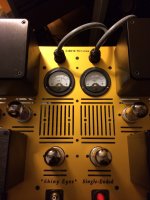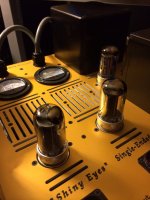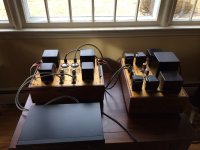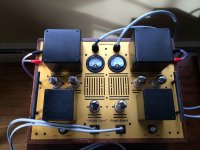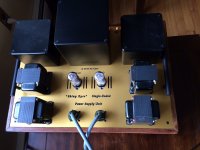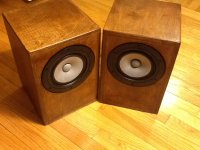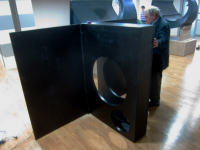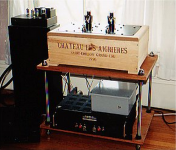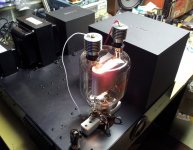All 4P1L, all DHP triode strapped amp
Andy,
I will post few details and pictures of my second amp in the series named "Shiny Eyes" ( first is a parallel push-pull with 4P1L that I posted in http://www.diyaudio.com/forums/tube...dahl-zero-global-feedback.html?highlight=4p1l )
For more details you can visit my blog at simplepleasuretubeamps | Thermionic Tubes and Sound Revelations .
Here is a short description: driver 4P1L @ 154V/36mA/-8.5V filament bias starved at 560mA loaded on a LL1692A Alt"T" 2:3.5, final stage PSE 4P1L @254V/36mA/-21V filament bias at nominal 1300mA, loaded on a LL1664/70mA/3k:8. Rod Coleman filament regulators (agree with you that are well designed, not very expensive and ready to use). I built it using two identical oak enclosures with anodized 3mm aluminum top plates from ProtoPanel ( very good quality and price, they usualy have sales at 40% off). Power supply is a monster at over 50 lbs, using separate transformers for main ht, final's filaments and driver's filament, a total of 5. Rectifier tubes are 6CJ3 and filtration is CLCLC with all 8H/150mA Hammond chokes and most of the caps are Epcos polypropylene in oil. I used a 104dB headphones and could not hear any hum. I recently built a pair of small reflex speakers (I have an extra enclosure for whoever is interested in the US, too heavy for international) using MarkAudio's Alpair 12P full range drivers that am using to listen to my amp. Sound is amazing and you know it.
Best,
Radu
Great! I'm very interested in your amp. Can you post a schematic when you're ready? Are you using filament bias for both stages? Which Lundahls?
Andy,
I will post few details and pictures of my second amp in the series named "Shiny Eyes" ( first is a parallel push-pull with 4P1L that I posted in http://www.diyaudio.com/forums/tube...dahl-zero-global-feedback.html?highlight=4p1l )
For more details you can visit my blog at simplepleasuretubeamps | Thermionic Tubes and Sound Revelations .
Here is a short description: driver 4P1L @ 154V/36mA/-8.5V filament bias starved at 560mA loaded on a LL1692A Alt"T" 2:3.5, final stage PSE 4P1L @254V/36mA/-21V filament bias at nominal 1300mA, loaded on a LL1664/70mA/3k:8. Rod Coleman filament regulators (agree with you that are well designed, not very expensive and ready to use). I built it using two identical oak enclosures with anodized 3mm aluminum top plates from ProtoPanel ( very good quality and price, they usualy have sales at 40% off). Power supply is a monster at over 50 lbs, using separate transformers for main ht, final's filaments and driver's filament, a total of 5. Rectifier tubes are 6CJ3 and filtration is CLCLC with all 8H/150mA Hammond chokes and most of the caps are Epcos polypropylene in oil. I used a 104dB headphones and could not hear any hum. I recently built a pair of small reflex speakers (I have an extra enclosure for whoever is interested in the US, too heavy for international) using MarkAudio's Alpair 12P full range drivers that am using to listen to my amp. Sound is amazing and you know it.
Best,
Radu
Attachments
yes....
why? because DHT's have filaments that serve as cathodes also,
unless you inject negative voltage to each grids,
a common filament supply is impossible...
Thanks sir....
I would suggest Pieter's nanocrystaline core transformers over Hashimoto. IMO the former are very high resolution.
Nanocrystalline is easily saturared, 1.2T instead of 2T for SiFe. Cores must be much bigger for the same low end. And if you have such bigger core the high frequencies will be worse because there is much more winding capacity and the copper loss will be much more because there is more wire on it.
Secondly the best nanocrystine core are toroids, not the cut cores. Manufactures can not garantee the same physics properties toroids have for c-cores.
Better save your money for a good transformer manufacture as Monolith Magnetics or Tango
A little bit out topic...
I'm new to DH Triode/Pentode and want to build 4P1L Parallel SE amp , 2 channel....question is do I really need two separate Power trafo winding for the DH filament for stereo?
I have SMPS psu for the filament 5v, 10amps , do I need two for stereo....I thought 1 is sufficient since it has lots of current but someone says no....Why?
You need to think of the filament supply quite differently for filament bias. Don't start by imagining that it's like a usual heater supply, which basically just provides heat. Yes, you need a separate filament supply for each tube. Ideally that means a separate transformer for each tube - not a winding off another transformer. Why? Because the signal goes through the filament supply since the cathode resistor is part of the circuit. So in addition to heating the filament, the filament supply has to be ULTRA clean. So think that you are creating a PSU of the kind you need for a signal.
So start with a good EI transformer, not a toroid. Then ideally use choke input with a Hammond 159ZA for one 4P1L or a 159ZC for two. Or the equivalent. This will have a field around it so consider taking the filament supply out into a separate chassis. After the choke you need about 20,000uF or more if you like of capacitance. Then an umbilical to the main chassis where you have the filament boards (e.g. Rod's) on a heat sink of the right size. These should be as close as possible to the tubes. And then the cathode resistors are in the same circuit so they also need to be close.
This PSE 4P1L design is a simple circuit, but to get the rather special sound of which it is capable, ALL of the supporting power supplies and circuitry has to be of the highest quality - overkill is a good start. Think high Dunker Factor!
"Dunker Factor" is a piece of Hifi legend referring to weight-to-watts ratio of the creations of the immortal Thomas Dunker. 50 kilos to one watt would be a good Dunker Factor. Here's an example of his thinking and a couple of his favourite quotes:
http://www.goodsoundclub.com/Forums/ShowPost.aspx?PageIndex=1&postID=1942#1942
"I wish I could score everything for horns." - Richard Wagner.
"Our writing equipment takes part in the forming of our thoughts." - Friedrich Nietzsche
Last edited:
ah ok andy, gotcha......i have a quad of these 4P1L waiting to see action...
You need 6 of them for the whole amp. Actually, I suggest buying a box of 100. Once you enter the doors of the 4P1L universe, guided by the God of Filament Bias and his servant on Earth, Thomas Mayer, building 300b amps will seem like riding horses to work.
Damn, then my Dunker Factor is quite low, since my Midlife Crisis SET amps produce about 200W...even though they weigh nearly 80 kilos each.
By the way, the Monolith OPTs in these amps are amorphous core, and they go down to 7Hz small signal on the low end with no problem, 4Hz if I use 4dB feedback (not planned at the moment). Of course, they weigh 28 kilos each.
By the way, the Monolith OPTs in these amps are amorphous core, and they go down to 7Hz small signal on the low end with no problem, 4Hz if I use 4dB feedback (not planned at the moment). Of course, they weigh 28 kilos each.
Attachments
Damn, then my Dunker Factor is quite low, since my Midlife Crisis SET amps produce about 200W...even though they weigh nearly 80 kilos each.
By the way, the Monolith OPTs in these amps are amorphous core, and they go down to 7Hz small signal on the low end with no problem, 4Hz if I use 4dB feedback (not planned at the moment). Of course, they weigh 28 kilos each.
I think Thomas Dunker will credit you with 80 kilos per amp, though I don't know what he'd do with 200W into his horns. This might propel him to Mars on a good day with a following wind....
Would Monolith do an OPT for a PSE 4P1L? That's the same specifications as a 300b - around 3.5K and 80mA. What do you think of Monolith in terms of sound, and what's your experiences of dealing with them?
Why not ask them? Here's their contact page:
contact
Ward and Yves have been pleasant to work with. Ward and I shared schematics and design ideas (he also has an 833 amp) and I'd definitely use them again. The delivery took longer than expected for my OPTs, but I think I was the first commercial customer for the S-883 OPT.
The sound is excellent - I have only built one of two monos to date so I can't comment on imaging and soundstage, but the amps are very dynamic and crystal clear.
The OPTs are not inexpensive, however.
.
contact
Ward and Yves have been pleasant to work with. Ward and I shared schematics and design ideas (he also has an 833 amp) and I'd definitely use them again. The delivery took longer than expected for my OPTs, but I think I was the first commercial customer for the S-883 OPT.
The sound is excellent - I have only built one of two monos to date so I can't comment on imaging and soundstage, but the amps are very dynamic and crystal clear.
The OPTs are not inexpensive, however.
.
Last edited:
Why not ask them? Here's their contact page:
contact
Ward and Yves have been pleasant to work with. Ward and I shared schematics and design ideas (he also has an 833 amp) and I'd definitely use them again. The delivery took longer than expected for my OPTs, but I think I was the first commercial customer for the S-883 OPT. The sound is excellent - I have only built one of two monos to date so I can't comment on imaging and soundstage, but the amps are very dynamic and crystal clear. The OPTs are not inexpensive, however.
.
I looked up the website. The Etude 1 for 300b is indeed €556 a pair. That's the same as the Hashimoto H-20-3.5. Just a bit more than the Tango U-789. Lundahl LL1620 or LL1623 is €450 a pair. Going cheaper you come to James 6123H at €205 a pair and then Silk at €366 a pair. Then there's Daburu DX-35A at €205 a pair and Softone R core at €198 a pair - this one did very well in the ETF shootout, though it has low inductance on the primary. Then there's Electraprint, Sowter, Magnaquest and so forth, and O-netics (probably only available in small quantities now). Monolith is definitely at the higher end, not counting exotic core materials.
Nanocrystalline is easily saturared, 1.2T instead of 2T for SiFe. Cores must be much bigger for the same low end. And if you have such bigger core the high frequencies will be worse because there is much more winding capacity and the copper loss will be much more because there is more wire on it.
Secondly the best nanocrystine core are toroids, not the cut cores. Manufactures can not garantee the same physics properties toroids have for c-cores.
Better save your money for a good transformer manufacture as Monolith Magnetics or Tango
Amorphous cores are susceptible to saturation as well, but I'm sure the 4p1l pse builders will tell you their Lundahl AM sound very good with their amps.
I can only describe what I heard with a 300B SET.... Tribute's nanocrystaline cores were an improvement from Lundahl AM OPT. Not massive, but an improvement none the less (biggest difference in mid/HF transparency).
andy I think wait times were 6-12 months.
And what about with Transcendar?Then there's Electraprint, Sowter, Magnaquest and so forth, and O-netics ....
I'm going to build an amplifier for my friend, who ordered Transcendar OPTs.
And what about with Transcendar?
I'm going to build an amplifier for my friend, who ordered Transcendar OPTs.
Yes, should have mentioned Transcendar too and no doubt others. I'm in Europe and the problem here is that generally you pay import tax on US goods but it seems that usually you don't on Asian goods, and of course European ones. So I'm biased that way.
Without details about copper loss, frequency response, resonances you can not say that it sounds better because of the core differance. Even "sounds better" is tricky.
Amorphous cores are susceptible to saturation as well, but I'm sure the 4p1l pse builders will tell you their Lundahl AM sound very good with their amps.
I can only describe what I heard with a 300B SET.... Tribute's nanocrystaline cores were an improvement from Lundahl AM OPT. Not massive, but an improvement none the less (biggest difference in mid/HF transparency).
andy I think wait times were 6-12 months.
Without details about copper loss, frequency response, resonances you can not say that it sounds better because of the core differance. Even "sounds better" is tricky.
Well, there are so many problems with comparative tests as we know. The question is what is "informative" - useful information. If two different OPTs were connected up to the same amp and speakers - just changing the OPT in the circuit - I would say that even a subjective opinion is "informative" assuming the listener is musical, in good health, of a critical nature and sober.
It's so hard to get any comparative information on OPTs that we have to make do with what we have.
I am affraid that a lot of manufactures not give information because its not in there interest.
Well, there are so many problems with comparative tests as we know. The question is what is "informative" - useful information. If two different OPTs were connected up to the same amp and speakers - just changing the OPT in the circuit - I would say that even a subjective opinion is "informative" assuming the listener is musical, in good health, of a critical nature and sober.
It's so hard to get any comparative information on OPTs that we have to make do with what we have.
- Home
- Amplifiers
- Tubes / Valves
- One more 4P1L SE
